A History of the Coastguard in the Hastings Area by Steve Peak (an Auxiliary Coastguard with the Hastings Company for 22 years)
 |
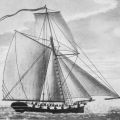 |
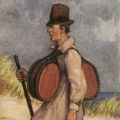 |
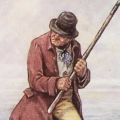 |
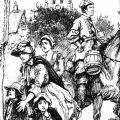 |
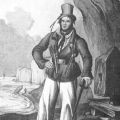 |
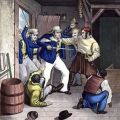 |
HM Coastguard is today a life-saving service, but it owes it origins to the government’s attempts in the 18th and early 19th centuries to stop smuggling - “the offence of importing or exporting specified goods that are subject to customs or excise duties without having paid the requisite duties” as A Dictionary of Law defines it. Coastguards and Smugglers tells the story of the Coastguards in the Hastings area, and how the ‘sentinels’ of almost two centuries ago ‘blockaded’ the coast against the ‘runners’.
Smuggling began in the late 13th century, following the imposition of an export duty on wool to protect English weavers. Kent and Sussex had large flocks of sheep and were also England’s closest ports to the continent, prompting many local entrepreneurs to take up wool trading by stealth to avoid the tax. ‘Owling’, as it was known, was a major illegal trade for the next three centuries.
In the early days of smuggling, customs duties were charged mainly on imports, while excise duties were initially imposed on home-produced goods, such as beer, although it was later put on a wide range of imported goods as well. Both the taxes had the aim of raising funds for the government, often to finance warfare. The Board of Excise was set up in 1643, with the first excise duty being used to pay for the English Civil War, then taking place. The Board of Customs was formed in 1671 to rationalise and improve the way the increasing number of import duties were collected, and in an unsuccessful attempt to bring owling to a halt. The two Boards were both responsible to the Treasury, but they were to remain as completely separate, and often competing, organisations until they were merged in 1909.
Customs officers since at least 1559 had had the power to decide the only places around the coast where foreign trading ships could discharge and load. The new Board of Customs re-thought the system, resulting in the coastline being divided into lengths called ‘Ports’, based around the most significant port in that area. Within each Port the Board defined which were the only legal quays and landing places for foreign trade. As part of this, in 1680 Sussex was split into five Ports, with Hastings designated a legal landing place in the ‘Port of Rye’. (These three words are painted on the sterns of Hastings fishing boats, because the 1843 Sea Fisheries Act required all fishing boats to be registered at their local Customs Port; hence also the letters RX in their registration number, meaning Rye, SusseX.) The Port of Rye ran from Jury’s Gap to Beachy Head, and the only other legal landing places within it initially were Rye and a quay at Pevensey Bridge. Each had Customs officers on duty, plus an office, often called the ‘Customs house’. The Hastings landing place was defined as an “open place or beach at Hastings from rock to rock, being the southernmost part of the said town towards the sea” (ie, between the East and West Hills).
The high cost of William III’s wars in France, Scotland and Ireland after he seized the throne in 1689 resulted in the customs and excise taxes being greatly widened, imposing high import duties on luxuries such as tea, tobacco, brandy, wine and silks. This made smuggling even more financially attractive to entrepreneurial law-dodgers, and from the 1690s prompted a rapid escalation in armed and violent ‘running’. This in turn forced the government to take tough new measures to try to stop it, creating a virtual civil war.
The Board of Customs in 1698 was given the power to set up two new protection services: the revenue cutters and the riding officers. Cutters were an innovative form of fast sailing vessel recently developed by the Dutch: single-masted, fore-and-aft gaff-rigged vessels, capable of more sophisticated and complex sailing manoeuvres than any other craft. The revenue cutters - known briefly at first as ‘sloops’, then ‘cutters’ and finally as ‘cruisers’ - were stationed in 21 ports round the coast of England and Wales, with one at each port. The ‘land guard’ of riding officers were a force of about 300 mounted Customs officers, who patrolled the coastline. Along the Sussex and Kent coasts each officer had to cover, on his own, a ‘guard’ of some four miles, whilst elsewhere around Britain it was ten miles. In an emergency, the officer could ask for military help, usually being a small local unit of dragoons - regular mounted soldiers. The number of both revenue cutters and riding officers fluctuated over the following decades, but together they were to be the main government fighters against the smugglers until 1809.
The luxury goods - valuable but small in bulk - were readily available just across the Channel, and demand for them rose steadily in the early 18th century as the industrial revolution increased the wealth of the upper class. This, combined with economic depression affecting the lower class, led smuggling to become a well-organised and highly profitable import and export business. After about 1720 the emphasis of smuggling switched from exporting wool to importing the luxuries. Sussex and Kent were the front line counties straddling the shortest routes between the suppliers across the Channel and the London markets for the imports.
Graham Smith says in Something to Declare: “From the late 17th up until the early 19th century, smuggling was a major crime conducted on a colossal scale, the execution of which was violent, ruthless and bloody in the extreme, even when judged by the brutal standards of the time. The smugglers were encouraged and financed by the local gentry, protected by compliant magistrates, condoned by the clergy, aided and abetted by the ordinary people and at times facilitated by venal revenue officers. The illegal trade extended throughout the country and permeated every level of society; the smuggled goods found their way into virtually all households, from the most lowly to the highest.”
Smugglers were especially brutal and murderous in the 1720s-40s, killing anyone - revenue man, informer, helper - who stood in their way. Until the wiping out of the ruthless and violent Hawkhurst gang in 1748-49, the government’s forces trying to stop smuggling were inadequate and ineffective, with groups of up to a hundred armed ‘runners’ doing as they wished in much of the countryside. The Hawkhurst conflict brought an end to their wanton brutality but the smuggling trade increased dramatically during the following decades, as duties increased and the development of seaside resorts like Hastings boosted the demand for sophisticated goods. By the 1770s ‘running’ had become so prevalent in Kent and Sussex that there were entrepreneurs in every town and in almost all villages. Smugglers had become ‘free traders’, as they preferred to be known, openly engaging in a popular business.
Many smugglers in ports like Hastings were individuals or small groups of people operating at a local level, using their own boats and distributing in the neighbourhood. Hiding places for illegal goods included cellars, graves, churches, secret passages, barns, caves (like St Clements on the West Hill) and pubs, such as the Stag in All Saints Street and Hastings Arms in George Street.
But there was also large-scale smuggling, often organised by London traders. This was labour-intensive, requiring large numbers of helpers. Local people usually specialised in either shipping the goods across the Channel in small, fast craft, or in the land transport by night in horse convoys of the contraband to and from the beaches. Incoming goods were moved inland as quickly as possible, often being hidden in the dense woods and valleys of the Weald, on their way to the wholesale dealers in London. These London traders hired separate gangs in the coastal districts (such as Hastings and Rye) and in the Wealden parishes inland en route to London (eg, Hawkhurst, for Hastings and Rye). The large convoys were especially vulnerable to detection and needed to be heavily guarded. A typical clash happened at Hollington in 1735, with one smuggler shot dead.
Smuggling was widely supported by all types of people, because to the lower classes the transport of contraband was - like poaching, wrecking and bread-rioting - an assertion of traditional rights in difficult times, while the supporting gentry and trading classes saw it as a blow against the corruption of London politicians and monopolistic company merchants. It offered high wages to the lower class in an area where fishing, weaving and iron production were declining industries, and it gave a boost to the income of the upper class for giving a helping hand and turning a blind eye.
As Rudyard Kipling wrote in 'A Smuggler’s Song' -
“If you wake at midnight and hear a horse’s feet,
Don’t go drawing back the blind, or looking in the street,
Them that ask no questions isn’t told a lie,
Watch the wall, my darling, while the Gentlemen go by!
Five and twenty ponies,
Trotting through the dark;
Brandy for the Parson,
Baccy for the Clerk;
Laces for a lady, letters for a spy,
And watch the wall, my darling, while the Gentlemen go by!”
Britain was engaged in a series of wars through the 18th century, and the duties were steadily increased to raise the needed finance. But as duties went up, so did the incentive for smuggling. The Customs service was therefore further expanded where possible. One method was to improve the local Customs houses, which most ports and landing places had had since the late 17th century. Customs staff collected dues from boats and searched cargoes, while the house itself was the meeting place for merchants, shipowners and ships’ master to discuss commerce and seek information on all aspects of shipping. In Hastings there was a Customs house from at least the early 18th century, and probably earlier.
Hastings was an obvious smugglers’ base because it was a long-established port, if not an official Customs ‘Port’. It had a large number of indigenous fishermen and seafarers who were used to handling small boats in difficult conditions, and for whom smuggling could bring much better earnings. In addition, the many cliffs, glens and inlets between Galley Hill in the west and Cliff End in the east provided well-hidden landing places. Hastings for many centuries had also had strong trading and cultural connections with France, as Boulogne was only 45 sailing miles from the town, in an easy straight line, while London was more than 140 difficult twisting and turning miles.
From 1733 the Customs onshore anti-smuggling forces of Kent were run by the most influential man in Hastings, John Collier (1685-1760), a solicitor, judge advocate, property manager, banker and government agent. In 1756 he passed on his anti-smuggling role - called Surveyor General of the Customs for Kent - and leading position in the town to his son-in-law Edward Milward Snr (1723-1811). Local legend has it that Collier and Milward (who was mayor of Hastings 26 times) received large incomes from their liaison with the chief smugglers over several decades, as did other Customs officers around the coast. The senior officers were well-known for having little effect, because their positions were often filled by political jobbery; corruption, inefficiency and laxity were widespread
Edward Milward Jnr inherited the fortunes and large estates of both his father and Collier, and this included the three miles of cliffs east from Rock-a-Nore to Fairlight that have always formed a major part of the coastline covered by the Hastings Coastguards. This attractive area, now part of the Hastings Country Park Nature Reserve, was never sold for development because most of the inheritors of the Milward estate were public-spirited charity benefactors who loved the glens, cliffs and woodland.
Hastings was a base not only for smugglers and their opponents, but also for ship-builders who supplied both sides of the war with high quality vessels with which to fight each other. The favourite vessel of both friend and foe was the gaff cutter, the design of which had evolved into a true thoroughbred by the 1780s, thanks to the key role the vessel played in both carrying out smuggling and in trying to stop it. By then the revenue cutters had acquired a large sail area and a very long bowsprit, up to four-fifths the length of the hull, which together made the vessel especially agile and fast. A law of 1787 made it illegal for any other craft to have such a bowsprit.
One of the best-known builders of the cutters on the south coast was the Hastings partnership Ransom and Ridley. William Ransom and William Ridley, both born 1770, were making vessels by at least 1801. They built their first revenue cutter in 1811 and made them on a regular basis for the Customs from 1822 until 1841, being then one of the Board’s three preferred builders on the south coast. In those two decades this respected firm built many craft, of all shapes and sizes, for ports all round the coast. In 1833 they constructed a 72-ton revenue cruiser called Prince George, which Prince George himself launched that April, the only recorded launching of any revenue vessel by royalty. Their shipyard was on the beach where today Albert Road meets the A259.
Increasing hostilities with the French from the late 1780s, and the aid given to Napoleon by the smuggling trade, led the British government to try to strengthen the coastal defence forces. But the 1780s had been the boom years of smuggling - their anarchic heyday - and strong action had to be taken to stop the ‘running’. In 1809 the Customs were given the go-ahead by the government to strengthen its preventive forces by setting up the Preventive Water Guard (PWG). In addition, the new Martello towers, built from 1805 against the French invasion that never happened, became good bases for the anti-smuggling units.
But the ending of the Napoleonic War in 1815 brought the discharge - and therefore unemployment - of about 330,000 soldiers and sailors, a good recruiting ground for smuggling at a time of widespread poverty in the rural south. The badly-run PWG was unable to stop the post-war surge in smuggling, so in 1816 the PWG was transferred from the control of the Board of Customs to the Admiralty, becoming more of a military force. In addition, the Navy from late 1816 replaced the PWG on the Kent and Sussex coast with a new ‘coastal blockade’ of armed sailors and marines on foot patrol. This was the first time regular units of the Navy had been used onshore in England as a law enforcement service. The PWG eventually merged with the other Customs forces to become the Coastguard in 1822, although the blockaded coast remained under the Admiralty until 1831
Smugglers had always been ready to forcefully defend themselves or to attack intruding officers, but the conflict became most violent in the clashes in the hard years of the 1820s, with both sides often being ready to fight to the finish. The last major conflicts in the Hastings area were at Sidley in 1828, Fairlight Glen in 1831 and Pevensey in 1833. But by 1831 the Navy had largely won its war against smuggling, and this, plus a Whitehall economy drive, brought an end to the coast blockade. .From the early 1840s a great reduction in import duties, plus a decline in public support for smuggling and the use of modern harbours rather than beaches as landing places, resulted in smuggling in places like Hastings almost disappearing. At the same time world trade was rapidly increasing, bringing a steady rise in shipping accidents. So from about 1850 the Coastguard began focusing on life-saving, now its main role